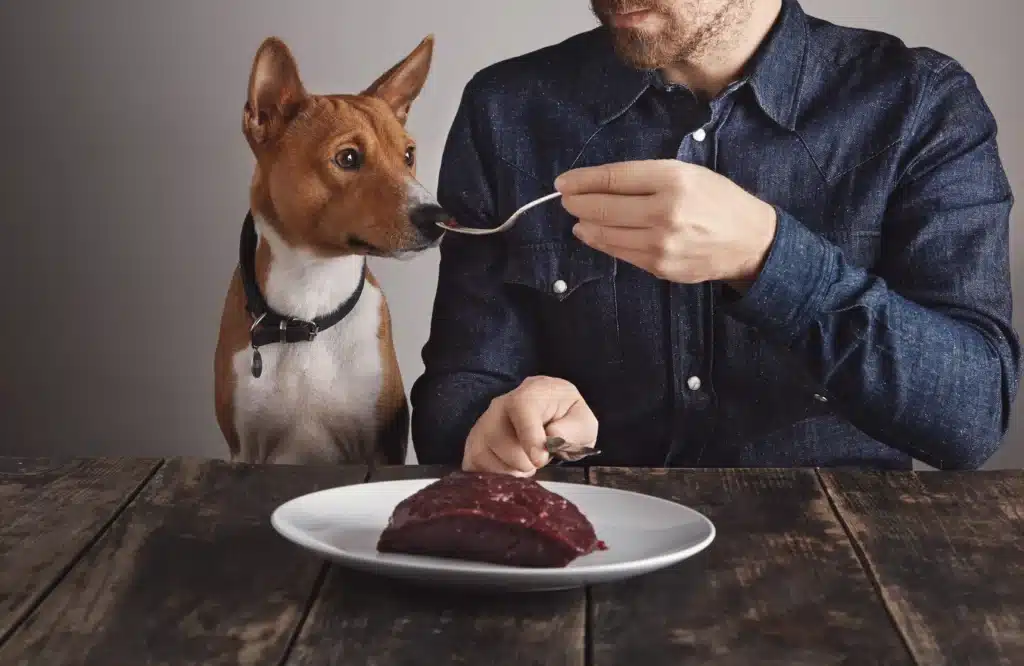Providing your small breed dog with the appropriate nourishment is among the most crucial things you can do to support a long, happy, energised life. Small breed dogs, like Yorkies, Pomeranians, granted some are small, but the nutritional needs are mighty. They require specific types of size-based food based on their small size, metabolism and activity levels.
Why Small Breeds Need Special Adult Dog Food
Compared to larger dog breeds, small breed dogs have a faster metabolism, therefore burning through calories quickly and require food that is nutrient-dense to maintain their energy. Additionally, small-breed dogs’ teeth and mouths are smaller, so they require a kibble that is easier to chew and digest.
Here are a few reasons why small-breed dog food is different:
Higher Caloric Density: To achieve the caloric requirements of their fast metabolism.
Smaller Kibble Size: To prevent choking and support oral health.
Optimised Protein Levels: They assist in lean muscle mass and maintaining proper body weight.
Balanced Fats and Omega Oils: To support skin health and an optimal coat appearance.
According to Cope, (2023) smaller dog breeds have a much higher mass-specific basal metabolic rate (BMR) than larger breeds, which simply means that they burn more calories for every pound of body weight, even at rest and with no activity. The literature suggests that Papillons have BMRs that are greater than 50% those of Great Danes (Lewis, 2023). Small breeds tend to have a higher percentage of lean body mass compared to large breeds.
What to Look for in Adult Small Breed Dog Food?
When selecting food for your small adult dog, specific age be mindful of the ingredient label on the packaging (American Kennel Club, 2017). The first few ingredients should always be real meat instead of fillers and by-products.

What to look for:
1. High-quality meat protein: Chicken, turkey, beef, or salmon.
2. Healthy fat: Omega-3 and Omega-6 to promote coat and joint health.
3. Digestible carbohydrates: Brown rice, oats, or sweet potato.
4. Antioxidants: for immune health and longevity, some slow down the ageing process.
5. Probiotics and fibre: for a healthy tummy.
Avoid: Artificial colours, preservatives such as BHA/BHT, corn, soy, and wheat – these ingredients can cause allergies and upset stomach.
Types of Low-Carb Dog Food
Low-carb options come in a variety of forms; fresh raw, specially formulated kibble, and freeze-dried or dehydrated blends. Each form has its own advantages depending on your dog’s health and activity level, as well as your convenience.
1. Raw/Fresh Low-Carb Diets
Raw or fresh diets typically rely on animal proteins and fats as the main source of energy, and they contain a low proportion of carbs.
Typical composition: 60 to 80% meat, 10 to 20% organs, 10 to 15% bone and <10% vegetables/fruits (Wild At Heart, 2025).
Pros: Good digestibility of nutrients, improved coat condition and muscle tone, decreased fecal volume and retention.
Cons: Potential risks of bacterial contamination (Salmonella, Listeria) or improper nutrient ratios.
Evidence: A review by Holm et al. (2025) reported better digestibility and greater gut microbiota diversity in dogs consuming raw low-carb diets compared to conventional kibble.
Example brands: Darwin’s Natural Pet, PetCubes Raw, BARF World.
2. Freeze-Dried or Dehydrated Low-Carb Food
Freeze-dried or dehydrated foods are low-carb diets that have been removed of moisture to increase shelf life and nutrient density.
Typical composition: 40 to 60% protein, 30 to 50% fat, <10% carbohydrate (Wendy Bumgardner, 2019).
Pros: Convenient in storage, minimally processed to retain natural flavor and enzymes.
Cons: More expensive per serving than kibble and may require rehydration.
Evidence: Freeze-drying maintains over 95% amino acid availability.
3. High-Protein, Low-Carbohydrate Kibble
Many premium kibble brands now offer recipes that contain fewer starch fillers and more meat.
Typical formulation: 35–45% protein, 15–25% fat, 20–30% carbohydrate (Pet Nutrition at OVC, 2022).
Benefits: Cost-effective, easy to store, meets the AAFCO standard for complete nutrition.
Disadvantages: May still use pea starch or lentils as carbohydrate sources, creating less carbohydrate than price-equivalent diets; the processing of the kibble may reduce the bioavailability of some nutrients.
Evidence: In one study, dogs fed high-protein low-carb kibble had lower postprandial glucose and insulin levels than those fed high-carb diets (PMC, 2025).
Example brands include: Orijen Original, Acana Singles, Farmina N&D Low Grain, and Wellness CORE.
4. Canned, or Wet Low-Carbohydrate Dog Food
Wet foods tend to naturally have less carbohydrate content because they are made with animal protein and water and do not rely on carbohydrates for texture.
Typical formulation: 8–12% protein (by weight, ~40–50% dry matter), 5–8% fat, <5% carbohydrate (Sanderson, 2023).
Benefits: Contain high amounts of moisture to support hydration, and may be beneficial for older dogs or for dogs suffering from kidney disease.
Disadvantages: Not as shelf-stable and may be more expensive for shipping and/or storage.
Evidence: Wet diets with higher moisture content have been shown to increase satiety compared to calorie-equivalent diets with lower moisture content, which may improve weight control in dogs.
Example brands include: Tiki Dog Wildz, Ziwi Peak Canned, and Weruva Paw Lickin’ Chicken.
5. Ketogenic Diets Formulated by Veterinarians
These diets are designed to be used in a veterinary medical context, usually for dogs with seizures or those that are being managed for weight or glucose levels.
Typical diet formulation: 60–80% fat, 15–20% protein, 10-15% carbohydrate (Upton, 2018).
Pros: Once dog-specific formulations are used, ketogenic diets have been shown to decrease the frequency of seizures and to demonstrate neurological stability in dogs.
Cons: Should only be used under the guidance of a veterinarian due to the metabolic consequences of these diets.
Evidence: A recent randomized controlled study found that dogs fed an MCT-enriched ketogenic diet experienced a 48% decrease in seizure frequency compared to a control group (Nakatsuka et al., 2023).
Examples: Royal Canin MCT Diet, Ketona Dog Food, Visionary Pet Keto Formula.
6. Homemade Low Carb Diets
Many pet owners create their own balanced low-carb recipes at home made with lean meat, organs, eggs, and low-GI vegetables.
Pros: Complete control of diet contains zero fillers and preservatives.
Cons: If not properly supplemented, bone meal diets can lead to deficiencies in certain nutrients (especially calcium, zinc, B vitamins).
Recommendation: Any formulation should always be done using AAFCO or NRC guidelines with some input from a veterinary nutritionist (WSAVA, 2024).
Feeding Guidelines for Small Breed Adults
All dogs are unique, which contributes to their required amount of food based on their age, activity level, and metabolism. However, small breeds require more per pound than larger dogs.
| Weight (kg) | Daily Food Amount | Feeding Frequency |
| 2–4 kg | ½ to 1 cup (Coates, 2020). | 2–3 meals/day |
| 5–7 kg | 1 to 1¼ cups (Coates, 2020). | 2 meals/day |
Tip: Always measure food portions with a proper cup, and adjust amounts based on your dog’s activity and body condition score (BCS).
Water should always be available; hydration is key, especially for dry kibble diets.
Best Feeding Practices for Small Breeds
Maintain consistency: Feed at the same time each day to help maintain metabolism.
Avoid overfeeding: Obesity is common in small dogs; use calorie content for portioning.
Diversify textures: Add wet food to dry kibble occasionally to add flavour and hydration.
Consistent dental care: Small breeds often experience dental disease; crunchy kibble is good for cleaning teeth.
Weigh regularly: Weigh the animal each month, and contact a Vet if the animal’s weight changes dramatically.
Recommended Ingredients & Brands
Even though specific needs might be different, reliable brands such as Royal Canin Small Adult, Hill’s Science Diet Small Paws, and Wellness CORE Small Breed have shown a nutrient balance and met the requirements of the veterinary community.
Natural or raw diets (and specifically under the guidance of a veterinarian) can be beneficial if properly balanced with vitamins and minerals.
Transitioning from Puppy to Adult Food
Small breed dogs usually reach full maturity between 9 and 12 months of age (Snouts and Stouts, 2024). We recommend that you transition your puppy over the course of 7-10 days by mixing gradually increasing portions of adult food into your puppy’s current food to avoid stomach upset.
Also Read: When Should You Switch From Puppy to Adult Dog Food?
FAQs About Adult Dog Food for Small Breeds
When is the right time to transition my small-breed dog to adult food?
Between 9 to 12 months, depending on the breed and under a vet’s recommendation.
Can I feed my small-breed dog food for large breeds?
No. It isn’t a good idea, the puppy food for large breeds is less calorie-dense and has larger sizes of kibble, which could cause choking issues or malnutrition.
Is wet or dry food best for small breed dogs?
Both are fine; while dry food helps dental health, wet food creates a hydration balance. Many owners will create a mix of the two for their dog’s diet.
How much adult small breed dog food should I be feeding per day?
Typically, a dog requires between ½ – 1 ½ cups per day depending upon the dog’s weight, age, and activity. Refer to your vet for guidance and monitor your dog’s body condition (Snouts and Stouts, 2024).
Do small-breed dogs need grain-free food?
Not necessarily; take into consideration that your dog must have a grain allergy diagnosed. Whole grains like brown rice and, in moderation, oatmeal can be good sources of fibre and energy.
How do I know if dog food is good quality?
Look for named meat sources (for example, chicken or salmon), avoid filler ingredients, and verify AAFCO (Association of American Feed Control Officials) certification on the label.
Final Thoughts
Selecting an appropriate adult small breed dog food should focus on nutrient density, digestibility, and quality ingredients. A balanced diet is intended to keep your dog active with a shiny coat, a robust immune system, and general health.
As with any significant dietary changes, you should always consult your veterinarian first, because all small dogs deserve big nutrition.
References
American Kennel Club. (2017) American Kennel Club. [online] Available at: https://www.akc.org/expert-advice/nutrition/how-to-read-a-dog-food-label
Cope, M. (2023) Diets for Small Dogs – Whole Dog Journal. [online] Available at: https://www.whole-dog-journal.com/food/diets-for-small-dogs
Snouts and Stouts. (2024) How Much Should I Feed My Dog? A Comprehensive Guide for Pet Owners – Snouts and Stouts. [online] Available at: https://snoutsnstouts.com/health-and-wellness/how-much-should-i-feed-my-dog/
WSAVA (2024) Nutrition Guidelines – WSAVA. [online] World Small Animal Veterinary Association. Available at: https://wsava.org/global-guidelines/global-nutrition-guidelines.
Nakatsuka, K., Zanghi, B. and Hasegawa, D., 2023. Efficacy evaluation of a commercially available MCT enriched therapeutic diet on dogs with idiopathic epilepsy treated with zonisamide: a prospective, randomized, double-blinded, placebo-controlled, crossover dietary preliminary study. BMC Veterinary Research, 19(1), p.145.
Upton, J. (2018). The Keto Diet Is Super Hard—These 3 Variations Are Much easier to Follow. [online] Health.com. Available at: https://www.health.com/weight-loss/keto-diet-types.
Wild At Heart (2025). What to Feed Your Pet & How Much. [online] Wild at Heart Pets Raw Food Delivery. Available at: https://wildatheartpets.com/pages/what-to-feed-how-much?srsltid=AfmBOor8d1vzzYIr1LCNkJOzZpbEa6I6gYbe9RMmr0PuYYd5zqxLELgu.
Holm, S., Baarman, E., Anturaniemi, J., Hemida, M., Salin, S., Vuori, K.A., Moore, R. and Hielm-Björkman, A., 2025. The effect of a kibble diet versus a raw meat-based diet on energy metabolism biomarkers in dogs. The Veterinary Journal, p.106462.
Wendy Bumgardner (2019) How Much Protein, Carbs, and Fat Do You Need Each Day? [online] Available at: https://www.verywellfit.com/daily-diet-composition-calculator-charts-carbs-protein-fat-3861072.
Lewis, J.S. (2023). Characterising protein and amino acid requirements and metabolism in humans, dogs and cell lines with stable isotope methods – Nottingham ePrints. Nottingham.ac.uk. [online] doi:https://eprints.nottingham.ac.uk/74181/1/full%20thesis%20corrections%2012723.pdf.
Pet Nutrition at OVC. (2022). Carbs & Dogs. [online] Available at: https://ovcpetnutrition.uoguelph.ca/2022/11/17/carbs-dogs.
Coates, J. (2020). Are You Feeding Your Dog the Right Amount? [online] www.petmd.com. Available at: https://www.petmd.com/dog/nutrition/are-you-feeding-your-dog-right-amount.
Sanderson, S.L. (2023) Nutritional Requirements of Small Animals – Management and Nutrition. [online] MSD Veterinary Manual. Available at: https://www.msdvetmanual.com/management-and-nutrition/nutrition-small-animals/nutritional-requirements-of-small-animals.


